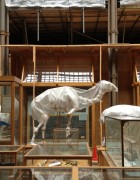I’ve been working on a design for a web application related to this research which is in early prototype stage. The application unfolds at three distinct stages.
1. Choose story layout.
A range of choices are available to select the comic page layout you prefer for your browser history comic. People can drag a layout into the main panel and content will automatically reflow into the panels. The current layout can be updated or changed by clicking or dragging in select panel. A preview of the completed comic is shown above the current layout. Current view has two states; full resolution with images in panels, info view with images greyed out and URL visible. In both states individual story panels are links to original sites. This design reflects how participants customised the comic page layouts I provided.
2. Add content
The websites in your browser history list are shown in a scrolling column to left. Three interactions are possible; ‘add’ allows you to add the website to the story by clicking or dragging, ‘forget for now’ allows you to keep the site visible but leave it for another story key image is greyed out, ‘forget forever’ means the website is deleted from the browser history list and it will not be available to the story. These three possible actions are intended to constitute the essential authoring tools for a browser history comic. Preview panel shows full colour version of comic. Alternative layouts are visible based on previous comics or the most popular. This design incorporates the finding that people choose what to include in their stories and a system that brings every website into a story is unrepresentative of how people think about their browser activity.
3. Publish
Previous comics in a certain time range are visible as outlines. Where there are more than four a horizontal scroller appears. The most comic is shown recent as a colour front page, options for tablet and mobile are given. All browser history comics are shown on a bookshelf, spines out, and annotated below with metadata on click or touch. Selected comic pages are shown as outlines when selection is made. All comic stories are shown in thumbnail scroller in footer. This design is a response to some participant suggestions for being able to page through their browser history in discrete authored units rather than a time stamped list.
Designing this framework for a web application or browser plug in brought up some tough questions. The quality of original participant responses with all their personal messy, artistic, subjective ambiguity has been lost. The richness of individual paintings and drawings disappears under the scaling requirements necessary for online distribution. One of the problems this research was intended to address is how digital experiences flatten experience to interface effects.
In order to make such a system work it will be necessary to algorithmically import a representative image of each website visited. Not only does this present a technical challenge, it also means using complex and invisible computation to create representations. Not every website has an image that speaks to what it means to people, the most important web content may be an email address or text clipping.
The creation of story in comic form is found in panel transitions and the relationship of text to image. If these are all pre-determined, albeit from a comprehensive but not exhaustive list, then some important part of authorial control is compromised. There should be a way to create your own layout using guidelines and adjustable boxes. Comic life does this really well.
Perhaps there is a different way of proceeding, one where instead of draining browser history comics of their individual touches and flattening them for online distribution, technology is brought to the paper pages themselves. I’ve been thinking about printing comics in conductive ink…





Reblogged this on Explore Everyday and commented:
Simple and well written article will proper guides